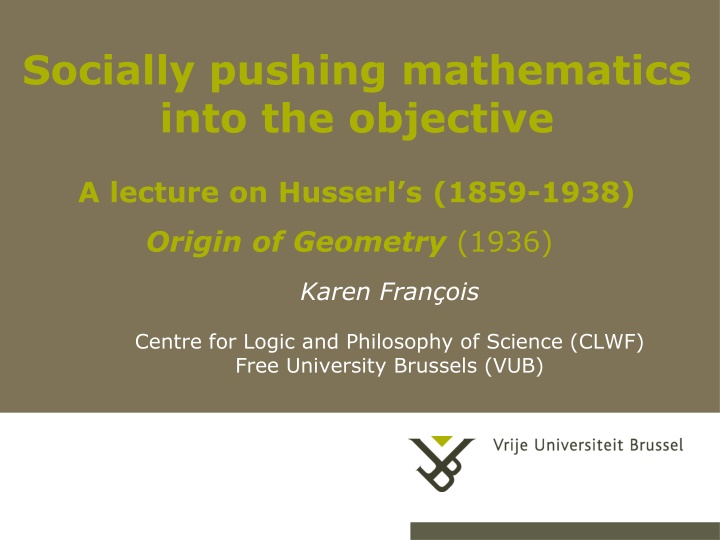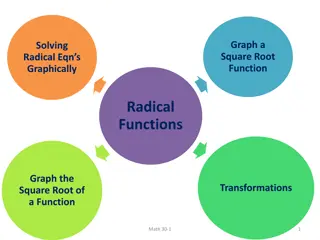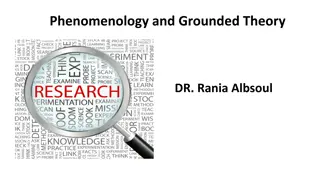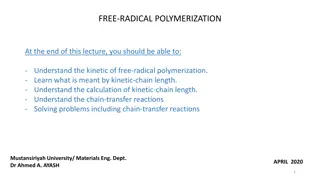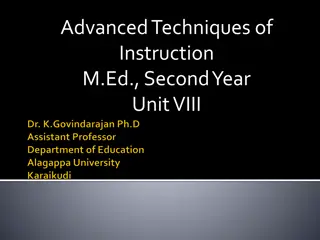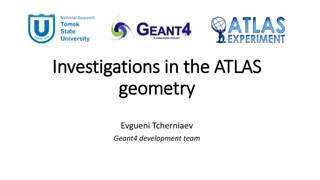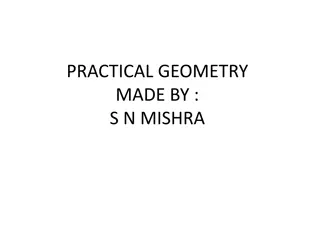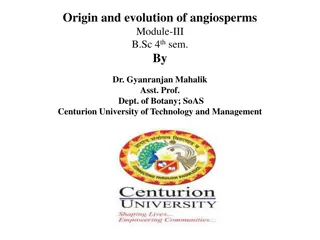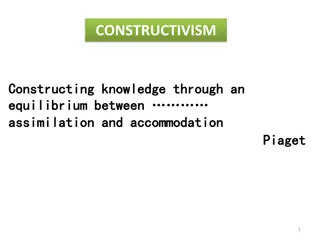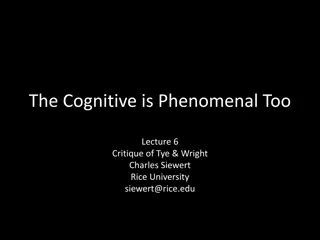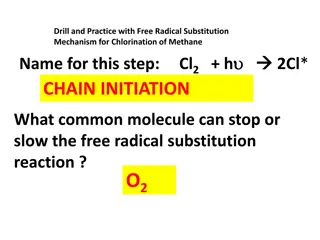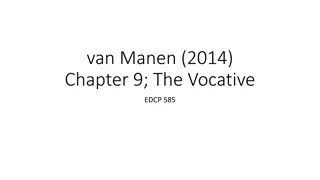Origin of Geometry: Phenomenology and Radical Constructivism
Radically exploring Husserl's Origin of Geometry and the intertwining of radical constructivism and phenomenology. Delve into the genesis of ideal objects in geometry, questioning how intrapersonal structures evolve into objective realities.
Download Presentation

Please find below an Image/Link to download the presentation.
The content on the website is provided AS IS for your information and personal use only. It may not be sold, licensed, or shared on other websites without obtaining consent from the author.If you encounter any issues during the download, it is possible that the publisher has removed the file from their server.
You are allowed to download the files provided on this website for personal or commercial use, subject to the condition that they are used lawfully. All files are the property of their respective owners.
The content on the website is provided AS IS for your information and personal use only. It may not be sold, licensed, or shared on other websites without obtaining consent from the author.
E N D
Presentation Transcript
Socially pushing mathematics into the objective A lecture on Husserl s (1859-1938) Origin of Geometry (1936) Karen Fran ois Centre for Logic and Philosophy of Science (CLWF) Free University Brussels (VUB) 22/04/2025 Cultures of mathematics IV New Dehli 2015 1
Overview Radical constructivism - phenomenology Genesis of The Origin of Geometry The process of the constitution: From the original being-itself-there to the ideal objectivity Discussion Cultures of mathematics IV New Dehli 2015 Pag. 22/04/2025 2
Radical constructivism criticized Radical subjectivism solipsism But all kinds of experience are essentially subjective, and though I may find reasons to believe that my experience may not be unlike yours, I have no way of knowing that it is the same. The experience and interpretation of language are no exception. (von Glasersfeld 1995: 1) (late) Husserl Husserl formulates the foundation of the constitution of the objects of all sciences. This constitution is a human praxis of knowledge or to speak in Husserl s terminology, an intentional process of consciousness, which constitute the objectivity of real objects. Cultures of mathematics IV New Dehli 2015 Pag. 22/04/2025 3
Genesis The Origin of Geometry 1936: text is written 1939: first posthumously published by Eugen Fink Brussels s Revue Internationale de Philosophie. Die Frage nach dem Ursprung der Geometrie als intentionalhistorisches Problem 1954: published as Beilage III of the Krisis in Husserliana. 1962: French translation with an extended introduction by Jacques Derrida L origine de la g om trie 1970: translated in English by David Carr The Origin of Geometry in The Crisis of European Sciences and Transcendental Phenomenology 1977: translated in Dutch by Joris Duytschaever with an introduction and an annotation by Rudolf Boehm Cultures of mathematics IV New Dehli 2015 4 Pag. 22/04/2025
Central question Our problem now concerns precisely the ideal objects which are thematic in geometry: how does geometrical ideality (just like that of all sciences) proceed from its primary intrapersonal origin, where it is a structure within the conscious space of the first inventor s soul, to its ideal objectivity?[i] [i] Husserl, 1970, pp. 357-358. Cultures of mathematics IV New Dehli 2015 5 Pag. 22/04/2025
Central question But the question arises again: How does the latter [the primally establishing geometer], in its ideality , thereby become objective? [ ] But how does the intrapsychically constituted structure arrive at an intersubjective being of its own as an ideal object which, as geometrical, is anything but a real psychic object, even though it has arisen psychically? Let us reflect.[i] [i] Husserl, op. cit., p. 359. Cultures of mathematics IV New Dehli 2015 6 Pag. 22/04/2025
Constitution Intra-subjective 1) the stage of the self-evidence 2) the condition of retention 3) the possibility of reawakeness Inter-subjective 4) the stage of communication 5) the a final stage of sedimentation. Cultures of mathematics IV New Dehli 2015 7 Pag. 22/04/2025
Intra-subjective stage 1: the stage of the self-evidence Self-evidence means nothing more than grasping an entity with consciousness of its original being-itself-there [seines originalen Selbst-da]. [i] [i] Husserl, op. cit., p. 356. Cultures of mathematics IV New Dehli 2015 8 Pag. 22/04/2025
Intra-subjective stage 1: the stage of the self-evidence But geometrical existence is not psychic existence; it does not exist as something personal within the personal sphere of consciousness: it is the existence of what is objectively there for everyone (for actual and possible geometers, or those who understand geometry). Indeed, it has, from its primal establishment, an existence which is peculiarly supertemporal and which of this we are certain is accessible to all men, first of all to the actual and possible mathematicians of all peoples, all ages; and this is true of all its particular forms.[i] [i] Husserl, op. cit., p. 356. Cultures of mathematics IV New Dehli 2015 9 Pag. 22/04/2025
Intra-subjective stage 2: the condition of retention Vivid self-evidence passes though in such a way that the activity immediately turns into the passivity of the flowingly fading consciousness of what-has-just- now-been. [i] [i] Husserl, op. cit., p. 359. Cultures of mathematics IV New Dehli 2015 10 Pag. 22/04/2025
Intra-subjective stage 3: the possibility of reawakeness Finally this retention disappears, but the disappeared passing and being past has not become nothing for the subject in question: it can be reawakened. To the passivity of what is at first obscurely awakened and what perhaps emerges with greater and greater clarity there belongs the possible activity of a recollection in which the past experiencing [Erleben] is lived through in a quasi- new and quasi-active way.[i] [i] Husserl, op. cit., p. 359-360. Cultures of mathematics IV New Dehli 2015 11 Pag. 22/04/2025
Inter-subjective stage 4: the stage of communication Its [the objective world] objective being presupposes men, understood as men with a common language. Language, for its part, as function and exercised capacity, is related correlatively to the world, the universe of objects which is linguistically expressible in its being and its being-such. [i] [i] Husserl, op. cit., p. 359. Cultures of mathematics IV New Dehli 2015 12 Pag. 22/04/2025
Inter-subjective stage 5: final stage of sedimentation. What is lacking is the persisting existence of the ideal objects even during periods in which the inventor and his fellows are no longer wakefully so related or even are no longer alive. What is lacking is their continuing-to-be even when no one has [consciously] realized them in self-evidence. The important function of written, documenting linguistic expression is that it makes communication possible without immediate or mediate personal address; it is, so to speak, communication become virtual. [i] [i] Husserl, op. cit., p. 360. Cultures of mathematics IV New Dehli 2015 13 Pag. 22/04/2025
Objectivity The Pythagorean theorem, [indeed] all of geometry, exists only once, no matter how often or even in what language it may be expressed. It is identically the same in the original language of Euclid and in all translations ; [ ].[i] [i] Husserl, op. cit., p. 357. Cultures of mathematics IV New Dehli 2015 14 Pag. 22/04/2025
Objectivity: Euclid (3C BC) & Liu Hui (3C AD) Cultures of mathematics IV New Dehli 2015 15 Pag. 22/04/2025
References Husserl, Edmund [1936] (1970). The Origin of Geometry. Appendix VI of The Crisis of European Sciences and Transcendental Phenomenology. Translated in English by David Carr, Evanston: Northwestern University Press. 1954: published as Beilage III of the Krisis in Husserliana. 1962: French translation with an extended introduction by Jacques Derrida, L origine de la g om trie. 1977: translated in Dutch by Joris Duytschaever with an introduction and an annotation by Rudolf Boehm, De oorsprong van de meetkunde. Francois K. (2011) On the notion of a phenomenological constitution of objectivity. In: Tymieniecka A-T. (ed.) Analecta Husserliana, issue Transcendentalism overturned. Springer, Dordrecht: 121 - 137. Glasersfeld E. von (1995) Radical constructivism: A way of knowing and learning. Falmer Press, London. Martinez-Delgado A. (2002) Radical constructivism: Between realism and solipsism. Science Education 86(6): 840-855. Cultures of mathematics IV New Dehli 2015 16 Pag. 22/04/2025
